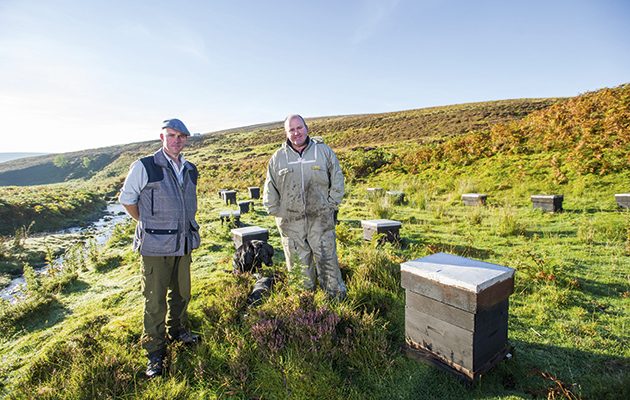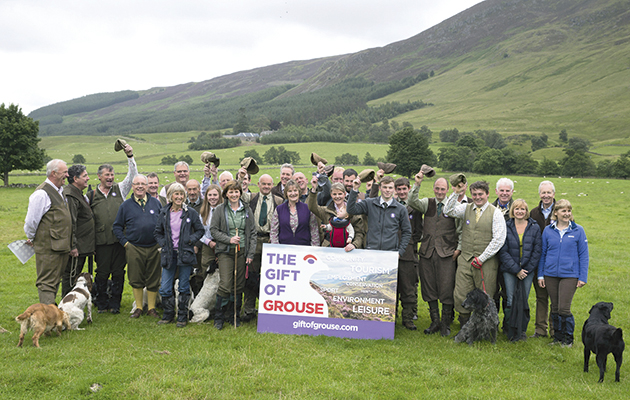A new campaign, the Gift of Grouse, is highlighting the positive impact that managing grouse moors offers to wildlife and local communities, as well as guns. Tim Baynes reports
The Gift of Grouse is a new campaign highlighting the benefits of grouse-shooting. It showcases the great work going on in some of our most remote regions. The campaign focuses on tourism and leisure, employment, environment and conservation. The Gift of Grouse highlights the contributions of grouse-shooting to the Scottish economy and landscape which are so often overlooked.
If you’d like to learn more about the benefits of grouse shooting as the season beckons, read the ‘Glorious Twelve’ benefits of grouse shooting.
THE GIFT OF GROUSE CAMPAIGN
There has long been a recognition that landowners need to improve their profile and tell the world how they are delivering for Scotland. Grouse management occurs in some of our most remote regions and there exists a significant knowledge gap between those familiar with estates and the rest of the population who have never visited one and have little understanding of rural affairs.
This lack of contact can lead to misunderstanding. The Gift of Grouse campaign was launched last year to address this and provide a platform on which to showcase the work carried out on sporting estates and explain how people and communities prosper thanks to the shooting industry. It focuses on four key pillars: tourism and leisure; employment; environment and conservation; and accessibility, to demonstrate the often overlooked contributions grouse-shooting makes to the Scottish economy and landscape.
The Gift of Grouse campaign explains how looking after the moorlands and wildlife in some of the remotest parts of Scotland benefits everyone. There are currently six regional moorland groups established across Scotland, from Loch Ness to the Lammermuirs, that have been getting their stories across in the media, representing their local communities’ activities and efforts, and engaging with regional politicians.
THE GIFT OF GROUSE: GENERATED INCOME
The income generated from grouse-shooting not only supports vital rural employment but also provides the money to underpin the conservation measures carried out on our behalf by land managers and gamekeepers. Moorland is where the red grouse makes its home but everyone who visits marvels at the magnificent purple heather that forms the backcloth to Scotland’s natural beauty. It also ensures a rich biodiversity, in which all forms of wildlife – including an extraordinary assemblage of birds, such as lapwing, curlew and golden plover – can flourish.
And while grouse-shooting has been long associated with elitism, the range of people participating in the sport is now wider than ever. There is the opportunity for young and old, male and female to take part, but accessibility is not solely built around the person taking the shot. The whole team around a day on the moor is part of the event, with beaters, flankers and gundog owners coming from varied backgrounds.

The Gift of Grouse campaign is highlighting the benefits of grouse-shooting which can be so often overlooked.
According to reports from sporting agents and rural hotels, shooting days booked and the occupancy rates in most parts of the country held firm last year, although many estates encountered a disappointing season and had to make cancellations to their 2015 programme due to the unfavourable weather over the breeding season.
Despite the rain and wind on the uplands of Scotland, investment and wages continued thanks to the resolute interest in the sport and the resilience of the industry as a result of the hard work and commitment devoted to it.
Grouse-shooting plays a major part in the £200 million that is generated for the economy by shooting and stalking every year. It contributes approximately £40 million plus in a good grouse year, with 970,000 bed nights purchased by tourists, both domestic and international, keen to enjoy Scotland’s world-class country sports.
THE GIFT OF GROUSE: TOURISM AND LOCAL BUSINESSES
It is difficult to imagine a scenario in which the tourism and, therefore, the revenue provided by visitors coming to remote Scottish villages and moorlands to shoot could be provided by any other means. For rural hotels, restaurants, cafés and garages, no shooting or stalking would mean a substantial reduction in tourists and it is likely that businesses would have to shut their doors during the winter months. That would lead to full-time staff becoming seasonal staff and, inevitably, many would then leave to search for work in Scotland’s big towns and cities.
For the mechanics at the garage who fix the vehicles of the local estates, the blow would be doubled by nearby hotels closing for months on end. For the local shops that rely on the trade from the mechanics, the impact would be considerable. And this hasn’t touched upon those who devote their careers to the land. The majority of those employed on shooting estates will be gamekeepers. They care and look after Scottish moorlands to ensure that the environment and a host of wildlife species can flourish. They also help care for the purple heather, so famous on Scotland’s hills, that is there for shooters and nonparticipants to cherish.
Land managers and gamekeepers also do a tremendous amount to support and enhance habitat and wildlife species. Since the campaign’s launch last year, the Scottish Moorland Group has conducted wildlife audits on three properties, which found a total of 81 bird species currently thriving on moors in Angus and Perthshire. The report on the findings was publicised at a reception at the Scottish Parliament hosted by MSP Graeme Dey.
To have such an array of species is tremendous news and demonstrates clearly that high-quality habitat management can deliver multiple conservation benefits. The diversity of species that can thrive on grouse moors is probably one of the least heralded gifts of grouse-moor management. We believe the findings of these studies are just a snapshot of what is happening on managed moorland throughout Scotland.
THE GIFT OF GROUSE: CONTINUED ENGAGEMENT
The Gift of Grouse has also revealed the work carried out on moorland to protect juniper plants, essential to gin production. Famous Hood’s Honey is sourced, as it has been for many years, on Hopes Estate in the Lammermuir hills. Promoting such partnerships is a key aim of the Gift of Grouse campaign and demonstrates that shooting estates are very much a part of local communities and that estate owners are keen to see local businesses succeed. Grouse-shooting estates don’t exist solely for leisure purposes; there are countless people involved in working to ensure that everything can flourish on our estates and the many gifts of grouse are widespread.
The Gift of Grouse campaign has demonstrated there is a strong appetite for news and political engagement by regional moorland groups. We need to continue to have estate owners and gamekeepers engaged and speaking out on behalf of their communities – the workload cannot be put upon the same estates. We have a strong collective voice and the shooting industry will only thrive when we work together.
THE GIFT OF GROUSE: LOCAL PROVIDERS
David Murray, the owner of Whitebridge Hotel in Stratherrick, near Inverness, benefits first hand from the positive impact the work taking place on grouse moorland has on businesses such as his and on the lives of his family, friends and neighbours.
“My wife, Sarah, and I have owned Whitebridge Hotel for 11 years,” he says. “To say we rely on the revenue generated by the grouse-shooting season and the shooting parties this brings to the hotel would be somewhat of an understatement. There is no large-scale industry to support the villages and communities here, as in many rural parts of Scotland. Our hotel benefits from the tourism generated by the nearby sporting estates such as Dell, Garrogie, Corriegarth and Dunmaglass, bringing vital customers to our hotel and restaurant, as well as to other local businesses. The income generated is needed for the survival of remote communities and businesses that don’t turn a profit during the quieter winter months. Business is very seasonal and the grouse season is vital for the sustainability of remote businesses throughout the year.”

The Whitebridge Hotel in Stratherrick hugely relies on the revenue generated by the grouse-shooting season.
Another rural businessman relying on the shooting season is Jeremy Clayton, who recently bought and converted an old farm steading into a shooting lodge on the Lower Dess Estate near Aboyne, Aberdeenshire. Despite only having opened Mill of Dess Lodge to sporting parties in late September last year, the lodge had a steady stream of guests until the end of the grouse season in December.
Clayton understands how popular country sports have become and wants it to be as accessible as possible for those wishing to experience a day on the hills and stay in a moorland lodge. “While shooting trips can still be expensive at the top end, I wanted to ensure people from all walks of life could enjoy a stay in Mill of Dess Lodge for an affordable price,” he says. “The more people we attract to the moorlands the more benefits it generates for the community as a whole, conservation projects and businesses alike.
“The Mill of Dess Lodge sleeps 20 guests and we have several nights taken for this year’s grouse-shooting season already so, weather permitting, 2016 already looks set to be a good year.”
THE GIFT OF GROUSE: AGENT’S OUTLOOK
Robert Rattray, head of sporting agency CKD Galbraith’s Sporting Lets, says: “The industry endured a wide range of challenges in areas that cater for grouse-shooting last year, where some estates did remarkably well while many suffered at the mercy of the Scottish weather. However, having looked at all evidence on the number of shooting days taken and the cancellations across the industry as a whole, it was clear the industry was more resilient than had been expected. Bookings remained healthy, which impacted positively on accommodation providers and local businesses.
“The international appeal of Scottish grouse-shooting remained undiminished and we witnessed an increase in groups coming from America, who regard Scottish grouse-shooting as an unrivalled, world-class sport. Groups not only consist of shooters but their partners and children, typically of around 16 to 18 in number and staying for two to three nights, where additional money is spent in local community providers and thus offering a lifeline at a time when business may well be very slow. Looking ahead, we are already witnessing some positive signs of a good season that will deliver once again for businesses and jobs in rural Scotland.”
Tim Baynes is the director of the Scottish Moorland Group









